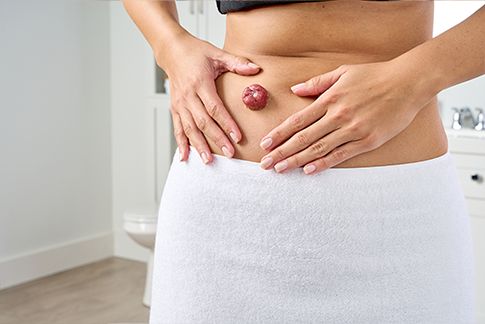Caring for Your Ostomy
When you come home from the hospital following your surgery, you may be anxious about handling your own ostomy care. Are you going to be able to do this yourself? Is it going to prevent you from doing things you enjoy? Will people be able to tell you have an ostomy?
Remember, millions of people live full and active lives with an ostomy — whether a urostomy, colostomy or ileostomy. With practice, the right ostomy products, and guidance from your wound, ostomy, and continence (WOC) nurse, you’ll find that caring for your ostomy isn’t as hard as you think.
Caring for Your Stoma
Your stoma may be red or pink, round or oval, protruding or flush with your skin. Expect your stoma to shrink somewhat in the first 6 to 8 weeks following your ostomy surgery.
You can safely touch your stoma. It has no nerve endings, so it won’t hurt. Snug clothing won’t hurt the stoma, but you should protect it from anything sharp that could damage it, such as a belt buckle.
The stoma may bleed slightly when cleaned or rubbed, and that’s normal. (Call your healthcare provider if it bleeds profusely, or if the bleeding doesn’t stop.) Clean your stoma gently with water.


Applying an Ostomy Pouch
After an ostomy, you won’t have control over the movement of stool (with an ileostomy or colostomy) or urine (with a urostomy). For this reason, you should wear an ostomy pouching system to collect output from your stoma.
There are various styles and sizes of pouch available, but they come in two basic types: a one-piece ostomy pouch and a two-piece ostomy pouch. With a one-piece pouch, the skin barrier (also called a flange, wafer, or base plate) and collection pouch are a single unit. With a two-piece pouch, you can change the pouch as often as needed while leaving the skin barrier attached for 2-4 days. This can be gentler on your skin and also makes it easier to change bags on the go.
Some pouches are drainable, meaning you can open the end of the pouch, empty the contents into the toilet, and reuse it. Others are closed, so they’re used only once and then discarded. Pouches typically include charcoal filters to release gas and neutralize any odor.
Whichever style you choose, a tight, leakproof fit is essential. If output from the stoma comes into contact with the surrounding skin, your skin can get irritated and injured. Use ostomy products such as a barrier ring or stoma paste to ensure a good fit between your stoma and your pouching system.
Emptying an Ostomy Pouch
Don’t wait too long to empty your pouch — it’s best to empty it when it’s 1/3 to 1/2 full. Most people with a urostomy empty the pouch every 2 to 4 hours. A colostomy bag may need to be emptied 2-4 times per day, while an ileostomy bag requires a more frequent schedule.
In short, the process involves sitting on or standing over a toilet, opening the end of the pouch, draining the contents into the toilet, then wiping and resealing the pouch.
Get more detail in our how-to guide: How to Empty an Ostomy Pouch


Caring for Your Peristomal Skin
Maintaining the skin around your stoma is crucial to living well with an ostomy. When the peristomal skin is healthy and intact, it’s easier to ensure a leakproof seal with your pouching system.
The output from a colostomy or ileostomy can damage the peristomal skin, if it leaks under the skin barrier. Frequent barrier changes also can damage the skin — this is called “skin stripping.” To prevent peristomal skin problems:
- Clean the peristomal skin every time you change your skin barrier, with water or with a gentle soap.
- Don’t use lotions, oils, creams or other nonmedical products on the peristomal skin.
- Always take time to inspect your peristomal skin. If you notice the beginning of a rash or other irritation, contact your WOC nurse or other healthcare provider.
- Change your ostomy products if they’re causing irritation. Try a different pouching system, or a barrier ring instead of stoma paste.
- Use the crusting technique to protect raw, weeping skin and allow it to heal.
Read more: How to Care for Your Peristomal Skin
When to Call Your Healthcare Provider
If you notice a problem with your stoma or peristomal skin, or if you have a question, don’t hesitate to contact your healthcare support team. It’s always better to address an issue right away than to wait and see what happens.
Call your WOC nurse if you have minor skin irritation, or any questions or problems with pouching or leakage.
You should contact your healthcare provider right away if you notice:
- A change in stoma color, from pink-red to purple, black or pale
- The stoma appears dry
- An increase or dramatic change in stoma size
- The stoma retracting or elongating
- Excessive bleeding from the stoma opening
- Bleeding between the stoma and skin
- Pain or sores on your peristomal skin
- Unusual bulging around your stoma
- A strong odor from the stoma
- Urine that’s bloody or foul-smelling
- An absence of bowel movements for more than 2 days
- You’re feeling dizzy or lightheaded
- Any unusual abdominal pain or continuous nausea and vomiting
You should call 911 or go to the emergency room if you notice rapid or dramatic changes in stoma color, or if you’re experiencing symptoms of severe cellulitis, such as high fever, chills, vomiting, and areas of skin that are red, hard, swollen, hot or painful.

Related Products

